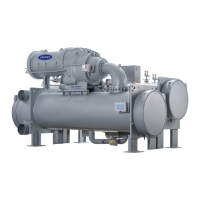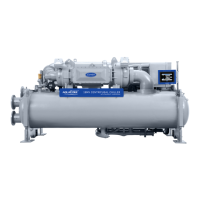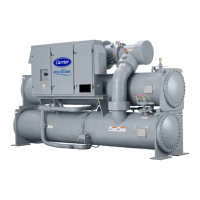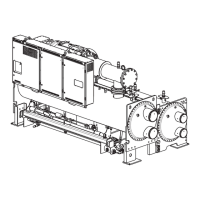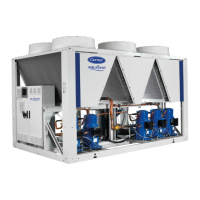18
Capacity Control — The PIC III controls provide
chilled liquid temperature control by modulating the frequency
of the power delivered by the VFD to the compressor motor.
The compressor speed is adjusted in response to the difference
between the CONTROL POINT and the LEAVING CHILLED
LIQUID or ENTERING CHILLED LIQUID temperatures.
The PIC III controls respond to the difference between the
CONTROL POINT and LEAVING CHILLED LIQUID tem-
peratures when the ECL CONTROL OPTION is DISABLED.
The PIC III controls respond to the difference between the
CONTROL POINT and ENTERING CHILLED LIQUID tem-
peratures when the ECL CONTROL OPTION is ENABLED.
The chiller capacity is controlled by varying the TARGET
VFD SPEED from 0% to 100%. The PIC III controls monitor
the compressor oil properties and set a COMPRESSOR MINI-
MUM SPEED to ensure sufficient compressor bearing lubrica-
tion under all operating conditions.
CONTROLS
Definitions
ANALOG SIGNAL — An analog signal varies in proportion
to the monitored source. It quantifies values between operating
limits. (Example: A temperature sensor is an analog device be-
cause its resistance changes in proportion to the temperature,
generating many values.)
DISCRETE SIGNAL — A discrete signal is a two-position
representation of the value of a monitored source. (Example: A
switch produces a discrete signal indicating whether a value is
above or below a set point or boundary by generating an on/off,
high/low, or open/closed signal.)
General Controls Overview — The 23XRV hermetic
screw liquid chiller contains a microprocessor-based control
center that monitors and controls all operations of the chiller.
The microprocessor control system matches the cooling
capacity of the chiller to the cooling load while providing
state-of-the-art chiller protection. The system controls cooling
capacity within the set point plus the deadband by sensing the
leaving chilled liquid or brine temperature (see Fig. 15 and 16)
and regulating the compressor speed. Reducing the compressor
speed decreases the volume flow rate of refrigerant through the
compressor. Chiller protection is provided by the PIC III
processor, which monitors the digital and analog inputs and
executes capacity overrides or safety shutdowns, if required.
PIC III System Components (Fig. 17-23) — The
chiller control system is called PIC III (Product Integrated
Control III). See Table 2. The PIC III control system controls
the chiller by monitoring all operating conditions. The PIC III
control can diagnose a problem and let the operator know what
the problem is and what to check. It promptly adjusts compres-
sor speed to maintain leaving chilled liquid temperature. It can
interface with auxiliary equipment such as pumps and cooling
tower fans to turn them on when required. It continually checks
all safeties to prevent any unsafe operating condition. It also
regulates the oil heater and regulates the hot gas bypass valve,
if installed. The PIC III controls provide critical protection for
the compressor motor and control of the variable frequency
drive.
The PIC III control system can interface with the Carrier
Comfort Network
®
(CCN) system if desired. It can also com-
municate with other PIC I, PIC II or PIC III equipped chillers
and other CCN devices, such as LEI (Local Equipment Inter-
face).
The PIC III controls are housed inside the control center
enclosure. See Fig. 2-4. The component names are listed
below (also see Table 2):
INTERNATIONAL CHILLER VISUAL CONTROLLER
(ICVC) — The ICVC is the “brain” of the PIC III control sys-
tem. This module contains all the primary software needed to
control the chiller. The ICVC is the input center for all local
chiller set points, schedules, configurable functions, and op-
tions. The ICVC has a stop button, an alarm light, four buttons
for logic inputs, and a backlight display. The backlight will
automatically turn off after 15 minutes of non-use. The func-
tions of the four buttons or “softkeys” are menu driven and are
shown on the display directly above the softkeys. The ICVC is
mounted on the control center door. See Fig. 2-4.
To change the contrast of the display, access the adjustment
on the back of the ICVC. See Fig. 17.
SHRINK WRAP
STRAIN RELIEF
1/8” NPT
THERMOWELL
REMOVABLE
TEMPERATURE
SENSOR
Fig. 15 — Control Sensors (Temperature)
a23-1624
Fig. 16 — Control Sensors
(Pressure Transducers)
a19-957
a23-1625
Fig. 17 — ICVC Contrast Adjustment

